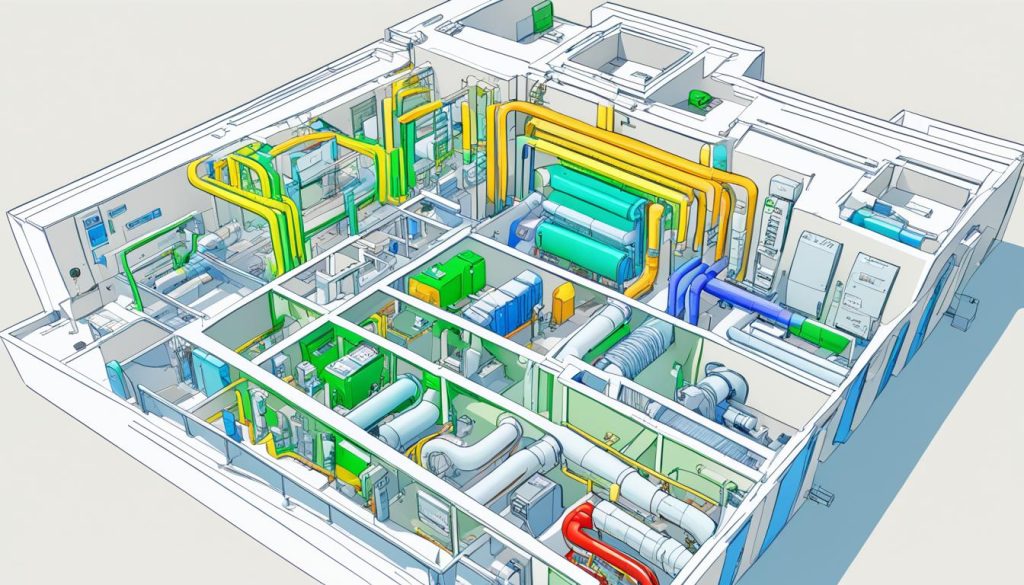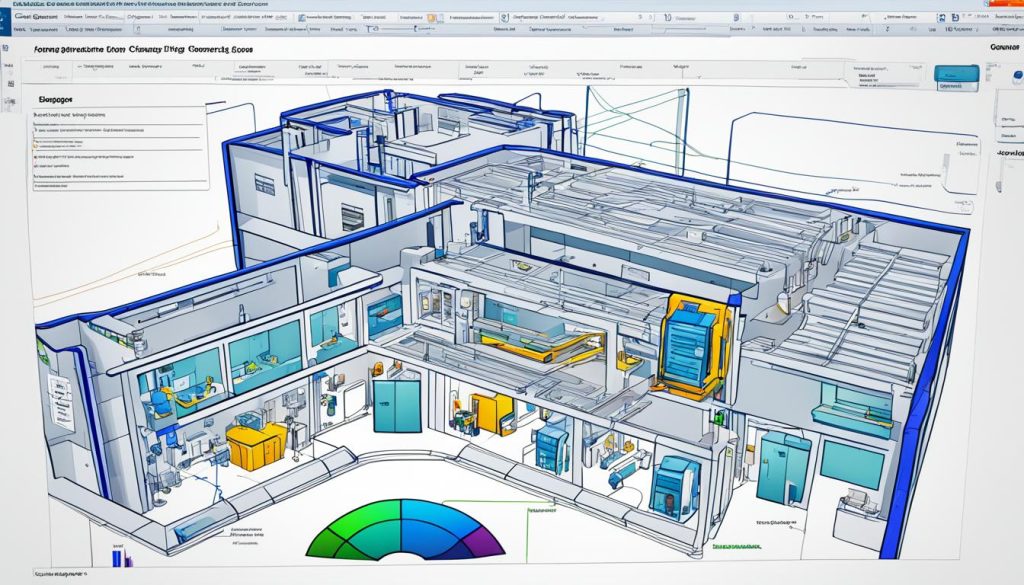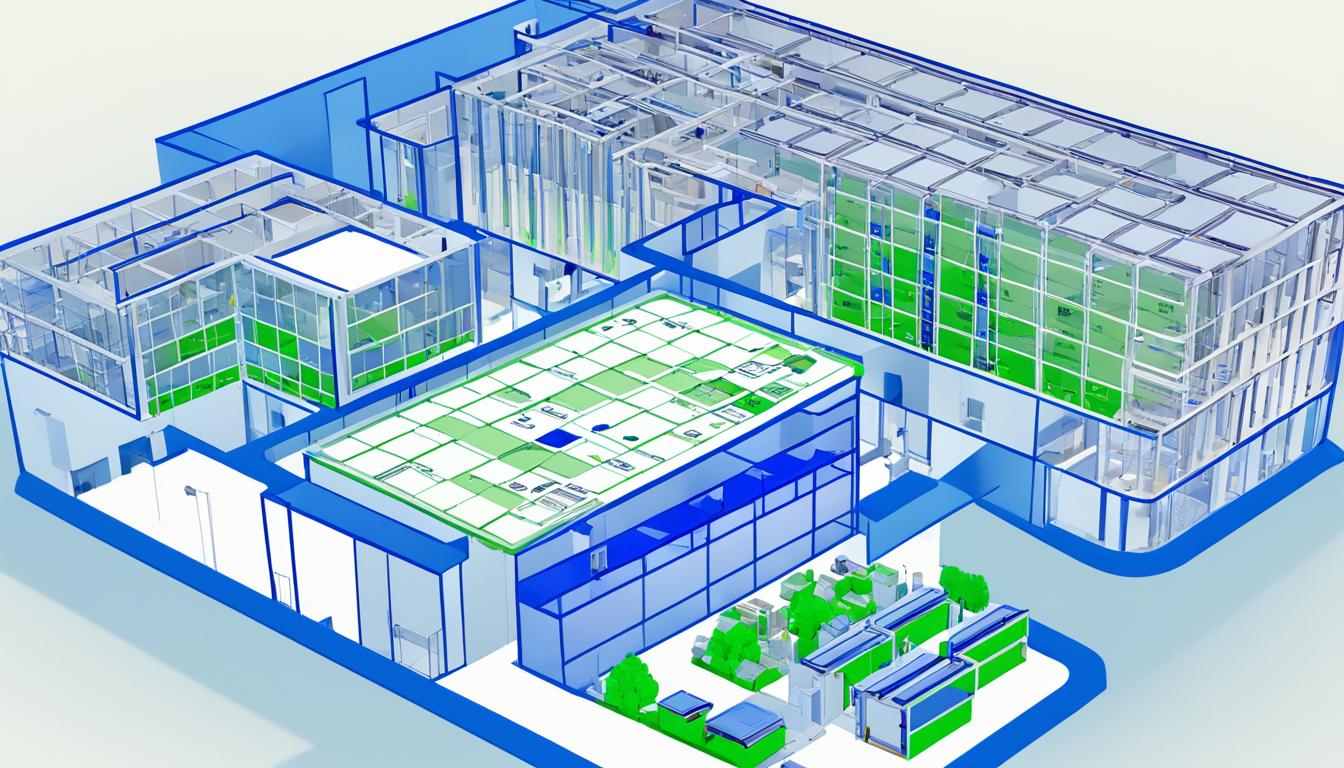Using load calculation software makes picking the right HVAC equipment easier. This tool does complex calculations automatically. It helps size your system right for the best performance and energy use.
This software changes how we design HVAC systems. It uses thermodynamic rules to find the highest loads for each area and the whole building. With this tech, you can make smart choices about what equipment to use. This leads to HVAC designs that save energy.
The software’s easy-to-use interface lets you enter detailed building info. You can think about changing factors and use current weather data. This detailed method means you get the right equipment size. It ensures comfort and efficiency while fitting your building’s needs.
By using HVAC load calculation software, you cut down on mistakes, save time, and improve system performance. This technology is crucial for making HVAC systems that are affordable, follow building codes, and meet standards.
Understanding the Importance of HVAC Load Calculation
HVAC load calculation is key to making sure your building’s heating, ventilation, and air conditioning systems work right. It helps figure out the best size and capacity for these systems. This way, you get the right amount of cooling and heating, making your system work better and use less energy.
The role of load calculation in system performance
Load calculation is crucial for making HVAC systems run smoothly. It looks at how much heat comes in and goes out because of things like temperature, sunlight, people, and machines. With this info, you can pick the right equipment size to avoid problems like short cycling or not enough cooling and heating.
Impact on energy efficiency and cost-effectiveness
Getting load calculations right makes your HVAC system more energy efficient and saves money. When your system is the right size, it uses less energy and cuts down on bills. Systems that are too big or too small waste energy or can’t keep you comfortable, showing why precise load calculations matter.
Meeting building codes and standards
HVAC load calculations are key for following building codes and standards. Groups like ASHRAE give rules for designing HVAC systems. Following these rules makes sure your system works well and keeps people comfortable. It also meets legal requirements.
| Benefit | Impact |
|---|---|
| Proper System Sizing | Improved comfort and efficiency |
| Energy Efficiency | Lower operating costs |
| Code Compliance | Legal conformity and safety |
The Evolution from Manual to Software-Based Load Calculations
HVAC design has changed a lot. Engineers used to spend hours doing manual calculations. This was slow and often led to mistakes. Now, computerized tools have changed everything.
Manual calculations were hard and took a lot of time. Engineers had to consider many factors. These included building materials, how many people would use the space, and the weather. Often, these calculations were wrong, making systems less efficient.
Automated load sizing has changed the game. Software can now solve complex heat balance equations quickly. This lets engineers test different scenarios fast. Because of this, HVAC designs are now much more efficient.
Modern load calculation software has many benefits:
- Faster computations
- Reduced human error
- Easy updates for changing building codes
- Better integration with other design tools
These tools are crucial as building rules get stricter. They help meet tough energy efficiency standards. Engineers can now quickly try out different designs. This leads to HVAC systems that are more sustainable and cost-effective.
The switch to computerized load calculations has changed HVAC design. It closes the gap between theory and reality. Engineers can now focus on making systems better, not just doing math. This change means buildings get HVAC systems that work better and use less energy.
Key Features of Modern HVAC Load Calculation Software
HVAC software has changed how experts design and improve heating, ventilation, and air conditioning systems. These tools have many features that make calculating loads easier and improve system performance.
Automated Complex Calculations
Modern HVAC software is great at solving complex heat balance equations. Just enter the building details, and it quickly does the hard math. This saves time and cuts down on mistakes. It helps in accurately sizing HVAC equipment.
User-Friendly Interfaces
Old, hard-to-use interfaces are gone. Today’s HVAC software has easy-to-use designs. You can easily add data, change settings, and make reports without needing a lot of training. This makes more professionals able to use these powerful tools well.
Integration with Other Design Tools
Integrated design tools change the game in HVAC planning. Load calculation software now works well with CAD programs, BIM systems, and energy analysis tools. This lets you work on projects more comprehensively and efficiently.
Real-Time Weather Data Incorporation
Having the right climate info is key for accurate load calculations. Modern HVAC software uses real-time weather data. It gives you the latest on temperature, humidity, and other conditions. This means your calculations are up-to-date, leading to better system designs.
These advanced HVAC software features work together to make calculations more accurate, save time, and improve system efficiency. By using these tools, you can design HVAC systems that fit building needs well. They also use energy better and keep occupants comfortable.
Streamline Equipment Selection with Load Calculation Software
Load calculation software changes the game in HVAC sizing. It makes picking the right equipment easy. With its smart algorithms, it gives you accurate results fast.
Forget manual calculations and guessing. Just enter the building details, climate, and how often it’s used. The software then creates detailed load profiles to help you choose the right equipment.

This software lets you test different scenarios in real-time. You can see how different equipment affects the system’s performance. This is key for making your HVAC design as efficient as possible.
| Manual Selection | Software-Assisted Selection |
|---|---|
| Time-consuming | Rapid results |
| Prone to human error | High accuracy |
| Limited scenario testing | Multiple configurations explored |
| Static calculations | Dynamic load analysis |
Using this software makes choosing equipment faster and more efficient. It works well with other design tools, making the process smooth from start to finish. This ensures your HVAC system works well and saves energy.
Enhancing Accuracy and Reliability in HVAC Design
Accurate HVAC design needs precise calculations and data analysis. Load calculation software has changed how engineers plan HVAC systems. It brings big improvements in accuracy and reliability.
Minimizing Calculation Errors
Load calculation software cuts down on human error in HVAC design a lot. It automates complex math, avoiding mistakes that manual calculations might have. This makes load estimation more reliable and helps avoid sizing problems that could impact system performance.
Detailed Building Information Integration
Today’s HVAC design tools use detailed building data. This includes architectural plans, material specs, and how people use the space. With these details, the software gives a better picture of what the building needs for heating and cooling.
Accounting for Dynamic Load Factors
HVAC load calculation software is great at handling dynamic factors in load estimation. It looks at things like daily temperature changes, sunlight, and how often equipment is used. This detailed approach leads to a more precise and effective HVAC system design.
| Factor | Impact on Load Calculation | Software Consideration |
|---|---|---|
| Occupancy Patterns | Affects heat gain from people | Analyzes hourly occupancy data |
| Equipment Usage | Influences internal heat generation | Calculates heat output over time |
| Weather Variations | Changes cooling and heating demands | Incorporates real-time weather data |
Using these advanced features, HVAC designers can get more accurate and reliable load estimates. This means better system sizing, more energy efficiency, and greater comfort for building occupants.
Time-Saving Benefits of Load Calculation Software
Load calculation software boosts HVAC design efficiency. These tools make the design process faster and more precise. They help you finish projects quicker and with better accuracy.

Rapid load calculation software reduces complex calculations from hours to minutes. This means you can spend more time on important HVAC system design aspects. Automated calculations let you quickly test different scenarios and improve your designs without waiting.
Modern load calculation tools have easy-to-use interfaces. Even if you’re new to HVAC design, you can quickly enter building details and make changes. This makes it easier to try out different designs and make improvements.
| Task | Manual Calculation | Software-Aided Calculation |
|---|---|---|
| Basic Load Calculation | 2-3 hours | 10-15 minutes |
| Multiple Design Scenarios | 1-2 days | 1-2 hours |
| System Optimization | 3-5 days | 4-6 hours |
Using these HVAC tools lets you take on more projects and deliver results faster. The quick load calculation features help you make fast changes to your designs. This lets you explore different options and find the best solutions for your clients.
Optimizing System Sizing for Peak Performance
Getting your HVAC system just right is key to keeping your building comfortable. Advanced load calculation software helps you avoid mistakes. It makes sure your system uses energy efficiently and meets your building’s unique needs.
Avoiding Under-sizing and Over-sizing Issues
Under-sized HVAC systems can’t keep up with comfort levels. On the other hand, over-sized systems use too much energy and cost too much. Load calculation software finds the ideal size for your building. It looks at peak loads and changes throughout the year. This ensures your system meets demand without wasting energy.
Balancing Comfort and Energy Efficiency
Finding the right balance between comfort and saving energy is crucial. Load calculation software lets you test different scenarios. This way, you can make smart choices for your building. It leads to better decisions and more sustainable operations.
Adapting to Specific Building Requirements
Every building is different and so are its HVAC needs. Load calculation software considers things like zoning, how often the building is used, and usage patterns. This customization ensures your HVAC system is perfectly sized for efficiency and performance.
| Factor | Impact on HVAC Sizing | Software Consideration |
|---|---|---|
| Building Orientation | Affects solar heat gain | Calculates sun exposure throughout the day |
| Occupancy Patterns | Influences peak load times | Models varying occupancy scenarios |
| Insulation Quality | Determines heat loss/gain | Accounts for R-values of building materials |
| Local Climate | Sets baseline heating/cooling needs | Incorporates historical weather data |
Integrating Load Calculation with Energy Modeling
Modern HVAC design uses powerful energy modeling software for efficiency. By linking load calculations with energy analysis, you can make your HVAC system better and cheaper. This method lets you pick the best system based on energy use and costs.
Now, load calculation tools easily work with energy modeling software. This combo gives you a full view of your HVAC system’s future performance. You can compare different options to find the best mix of comfort and savings. Some tools even use current utility rates to predict long-term costs.
The newest HVAC energy analysis software does more than just basic math. It looks at new tech like electric vehicle-ready heat pumps. With these tools, you can plan systems that meet today’s needs and tomorrow’s too. This way, your HVAC systems stay efficient and affordable for a long time.





0 Comments